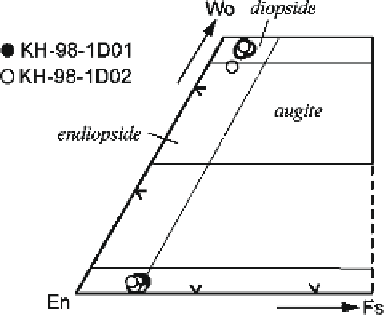Geoscience Reference
In-Depth Information
Fig. 3
Classification of Ca-rich
and Ca-poor pyroxenes on a
Wo-En-Fs ternary plot. Most
of the Ca-rich pyroxenes are
classified as diopside
the present study, other workers have reported the existence of basalt, gabbro, and
plagioclase-free peridotites (Bloomer and Hawkins
1983
; Fryer
1993
; Michibayashi
et al.
2009
).
Furthermore, along the inner wall of the southern Mariana Trench, west of the
present dredge sites, mantle peridotites are well exposed (Ohara and Ishii
1998
).
These peridotites are typically plagioclase-free and contain spinel with a high Cr#,
indicating that they represent the residue of a relatively high degree of partial melting,
probably related to “island-arc” type magmatism.
Therefore, plagioclase peridotites along the southern Mariana Trench are
restricted to the area along the fault at 144°E in the southern Marianas, indicating
that the magmatic and tectonic developments along the fault zone differ from those
along other parts of the southern Mariana Trench.
There are two possible explanations for the existence of plagioclase in resi-
dual peridotite: (1) re-equilibration of an ascending mantle as it moves from
the spinel-peridotite facies into the plagioclase-peridotite facies by the reaction
orthopyroxene + clinopyroxene + Al-spinel = olivine + plagioclase + Cr-spinel
(e.g., Hamlyn and Bonatti
1980
), or (2) impregnation of residual peridotite by
either an in situ or an exotic melt, and reaction between that melt and Al-spinel to
give plagioclase and Cr-spinel (Dick and Bullen
1984
; Dick
1989
).
In the Philippine Sea Plate, plagioclase-bearing peridotites have been reported
from the southern Marianas (Bloomer and Hawkins
1983
; Michibayashi et al.
2009
) and the Parece Vela Rift (Ohara et al.
2003
; Ohara
2006
). Michibayashi et al.
(
2009
) explained that the occurrence of plagioclase in the peridotites from the
southern Marianas can be attributed to the reaction of the peridotite with an impreg-
nating melt, based on the co-existence of both low-Cr# and high-Cr# spinels
in a single sample. Ohara et al. (
2003
) reported the occurrence of plagioclase in
peridotites from the Parece Vela Rift, and concluded that the plagioclase was pro-
duced by a reaction involving melt, based on the co-existence of fertile peridotite,
plagioclase-bearing peridotite, and dunite in a single dredge haul. In the case of the
peridotites in our study, the Cr# of spinel has constant value but different from piece
to piece, and most of the peridotites from each dredge site are plagioclase-bearing.

Search WWH ::

Custom Search